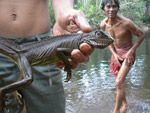
Jaguar in Brazil. A new study finds that apex predators, like the jaguar, are some of the most sensitive to environmental degradation both inside and outside tropical forest parks. Photo by: Rhett A. Butler.
Governments have set up protected areas, in part, to act as reservoirs for our Earth’s stunning biodiversity; no where is this more true than in the world’s tropical forests, which contain around half of our planet’s species. However a new study in Nature finds that wildlife in many of the world’s rainforest parks remains imperiled by human pressures both inside and outside the reserves, threatening to undercut global conservation efforts. Looking at a representative 60 protected areas across 36 tropical nations, the scientists found that about half the parks suffered an “erosion of biodiversity” over the last 20-30 years.
“These reserves are like arks for biodiversity. But some of the arks are in danger of sinking,” said lead author, William Laurance, from James Cook University and the Smithsonian Tropical Research Institute, in a press release. “Even though they are our best hope to sustain tropical forests and their amazing biodiversity in perpetuity.”
Laurance and colleagues conducted over 200 detailed interviews to survey changes in over 30 taxonomic groups (such as plants, primates, and top predators) in the protected areas. They found that many important groups were particularly sensitive to environmental changes inside and outside the park, including most large-bodied animals; amphibians; lizards; non-venomous snakes; freshwater fish; epiphytes; old-growth trees with large seeds; and top predators. Slightly less vulnerable species included primates, some birds, poisonous snakes, and migratory animals. Other groups—such as invasive species, lianas, vines, and some butterflies—actually did better when the park’s ecosystems were degraded.
“The scariest thing about our findings is just how widespread the declines of species are in the suffering reserves. It’s not just a few groups that are hurting, but an alarmingly wide array of species,” Carolina Useche with the Humboldt Institute said.
The study, the most comprehensive of its kind to date, found that 80 percent of the reserves had some loss in biodiversity, with around half showing serious decline. Inside protected areas the largest indicators of biodiversity loss was declining forest cover as well as an increase in logging, hunting, or harvesting of non-timber products.
“Almost as important is what’s going on outside it,” explains Kadiri Serge Bobo of the University of Dschang. “Eighty-five percent of the reserves we studied lost some nearby forest cover over the past two to three decades,” said Dr Bobo. “But only two percent saw an increase in surrounding forest.”
Deforestation, fires, and hunting on a protected area’s perimeters were shown to significantly hamper biodiversity within.
“For example, if a park has a lot of fires and illegal mining around it, those same threats can also penetrate inside it, to some degree,” Useche added.
On the plus side, the study found that good enforcement was key to better-performing protected areas.
“Reserves in which actual, on-the-ground protection efforts had increased over the past 20 to 30 years generally fared better than those in which protection had declined; a relationship that was consistent across all three of the world’s major tropical regions,” the researchers write.
The best reserves, however, must also creatively counter threats at the park’s edges. To do this, the scientists recommend establishing buffer zones around existing parks, creating corridors to connect parks, and working with locals to promote lower-impact activities.
“A focus on managing both external and internal threats should also increase the resilience of biodiversity in reserves to potentially serious climatic change,” the authors write.
More and smarter management efforts are needed if tropical forest parks are serve as biodiversity arks in an age of mass deforestation and climate change. The stakes are high: given that the world’s rainforests contain so many species, if their protected areas falter, mass extinction will be inevitable.
CITATION: Laurance, William F., and 215 coauthors. 2012. Averting biodiversity collapse in tropical forest protected areas. Nature, DOI:10.1038/nature11318.

Forest clearing for an oil palm plantation at the edge of Gunung Leuser National Park in Sumatra. New research shows that forest loss on park edges can hugely impact biodiversity within. Photo by: Rhett A. Butler.
Related articles
Flouting moratorium, Cambodia approves four land concessions in protected areas
(06/27/2012) A month-and-a-half after Cambodian Prime Minister, Hun Sen, declared a moratorium on on new economic land concessions, the government has announced four new concessions, each located in protected areas. Economic land concessions have come under the microscope in Cambodia after large-scale protests by local people and the recent murder of forest activist Chut Wutty. Critics say the concessions, which last year totaled two million hectares (4.9 million acres) sold off to foreign corporations, have resulted in local land conflict and environmental degradation.
Over half of world’s tiger reserves lack minimum protection

(05/21/2012) A year-and-a-half after a landmark summit that pledged to double the world’s number of tigers by 2022, and still 65 percent of tiger reserves lack minimum standards of protection for the world’s largest cat, according to the World Wide Fund for Nature (WWF). Reporting at the first meeting of all 13 tiger-range countries since the 2010 summit, WWF said that 41 tiger reserves of 63 did not have enough boots on the ground to combat tiger poaching.
Can loggers be conservationists?

(05/10/2012) Last year researchers took the first ever publicly-released video of an African golden cat (Profelis aurata) in a Gabon rainforest. This beautiful, but elusive, feline was filmed sitting docilely for the camera and chasing a bat. The least-known of Africa’s wild cat species, the African golden cat has been difficult to study because it makes its home deep in the Congo rainforest. However, researchers didn’t capture the cat on video in an untrammeled, pristine forest, but in a well-managed logging concession by Precious Woods Inc., where scientist’s cameras also photographed gorillas, elephants, leopards, and duikers.

(05/03/2012) Abandoned by NGOs and the World Bank, carved out for rubber plantations and mining by the Cambodian government, spiraling into a chaos of poaching and illegal logging, and full of endangered species and never-explored places, Virachey National Park may be the world’s greatest park that has been written off by the international community. But a new book by explorer and PhD student, Greg McCann, hopes to change that. Entitled Called Away by a Mountain Spirit: Journey to the Green Corridor, the book highlights expeditions by McCann into parts of Virachey that have rarely been seen by outsiders and have never been explored scientifically, including rare grasslands that once housed herds of Asian elephants, guar, and Sambar deer, before poachers drove them into hiding, and faraway mountains with rumors of tigers and mainland Javan rhinos.
Camera traps discover tigers, elephants in “empty” forest park

(04/16/2012) Although it’s named Namdapha Tiger Reserve, conservationists had long feared that tigers, along with most other big mammals, were gone from the park in northeast India. However, an extensive camera trap survey has photographed not only Bengal tigers (Panthera tigris tigris), but also Asian elephants (Elephas maximus), which were also thought extirpated from the park. Once dubbed an “empty forest” due to poaching, the new survey shows that Namdapha still has massive conservation potential.
Russia creates massive park for rare cats
(04/13/2012) Russia has created a massive national park to protect some of the world’s rarest big cats, the critically endangered Amur tigers and leopards, reports the Wildlife Conservation Society (WCS).
Turkey’s rich biodiversity at risk

(03/28/2012) Turkey: the splendor of the Hagia Sophia, the ruins of Ephesus, and the bizarre caves of the Cappadocia. For foreign travelers, Turkey is a nation of cultural, religious, and historic wonders: a place where cultures have met, clashed, and co-created. However, Turkey has another wealth that is far less known: biodiversity. Of the globe’s 34 biodiversity hotspots, Turkey is almost entirely covered by three: the Caucasus, the Irano-Anatolian, and the Mediterranean. Despite its wild wealth, conservation is not a priority in Turkey and recent papers in Science and Biological Conservation warn that the current development plans in the country, which rarely take the environment into account, are imperiling its species and ecosystems.
Over 5,000 vital biodiversity sites remain unprotected
(03/22/2012) A recent study has found that half of the world’s Important Bird Areas (IBAs) and Alliance for Zero Extinction (AZE) sites remain unprotected, leaving many endangered species, some on the verge of extinction, gravely vulnerable to habitat loss. Published in the open access journal PLoS ONE, the study urges governments to focus on expanding protected areas to cover the species that need it most.
Legal case against Serengeti road moves forward
(03/21/2012) A regional case against the construction of a proposed road through Serengeti National Park has moved to trial after a judge with the East African Court of Justice (EACJ) threw out concerns by Tanzania reports the Daily Nation. The government of Tanzania has proposed a controversial highway that would bifurcate the northern part of the Serengeti National, only to see their plans stalled by a lawsuit filed by the Kenyan-based NGO, Africa Network for Animal Welfare (ANAW), which argues that the road could have massive consequences for the entire Serengeti ecosystem, a view shared by many scientists.
Cambodia sells off national park for city-sized pleasure resorts
(03/19/2012) The Cambodian government has handed over nearly 20 percent of Botum Sakor National Park to a Chinese real-estate firm building a massive casino and resorts in the middle of pristine rainforest, reports Reuters. The city-sized resorts, costing $3.8 billion, will include a 64 kilometers highway, an airport, hotels, and golf courses. Botum Sakur is home to a number of endangered species including the pileated gibbon (Hylobates pileatus) and Asian elephant (Elephas maximus).
Wildlife corridor key to conserving tigers, rhinos in Nepal
(03/19/2012) A single forest corridor links two of Nepal’s great wildlife areas: Chitwan National Park and the Mahabharat mountain range, also known as the “little Himalayas.” The Barandabhar Forest Corridor (BFC) has become essential for the long term survival Nepal’s Indian rhinos (Rhinoceros unicornis) and Bengal tigers (Panthera tigris tigris). Yet, according to a new paper published in mongabay.com’s open access journal Tropical Conservation Society (TCS), the corridor is imperiled by deforestation, a highway, and inconsistent management policies.